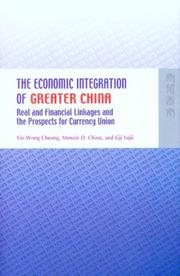| Listing 1 - 10 of 12 | << page >> |
Sort by
|
Book
Year: 1997 Publisher: Cambridge, Mass. National Bureau of Economic Research
Abstract | Keywords | Export | Availability | Bookmark
 Loading...
Loading...Choose an application
- Reference Manager
- EndNote
- RefWorks (Direct export to RefWorks)
Book
Year: 1997 Publisher: Cambridge, Mass. National Bureau of Economic Research
Abstract | Keywords | Export | Availability | Bookmark
 Loading...
Loading...Choose an application
- Reference Manager
- EndNote
- RefWorks (Direct export to RefWorks)
Digital
Year: 1997 Publisher: Cambridge, Mass. National Bureau of Economic Research
Abstract | Keywords | Export | Availability | Bookmark
 Loading...
Loading...Choose an application
- Reference Manager
- EndNote
- RefWorks (Direct export to RefWorks)
Digital
Year: 1997 Publisher: Cambridge, Mass. National Bureau of Economic Research
Abstract | Keywords | Export | Availability | Bookmark
 Loading...
Loading...Choose an application
- Reference Manager
- EndNote
- RefWorks (Direct export to RefWorks)
Book
Year: 1998 Publisher: Vienna ONB
Abstract | Keywords | Export | Availability | Bookmark
 Loading...
Loading...Choose an application
- Reference Manager
- EndNote
- RefWorks (Direct export to RefWorks)
Book
ISBN: 9780393076509 Year: 2011 Publisher: New York Norton
Abstract | Keywords | Export | Availability | Bookmark
 Loading...
Loading...Choose an application
- Reference Manager
- EndNote
- RefWorks (Direct export to RefWorks)
Budget deficits --- Debts, External --- Debts, Public --- Financial crises --- United States --- Economic conditions
Book
Year: 2008 Publisher: London Centre For Economic Policy Research
Abstract | Keywords | Export | Availability | Bookmark
 Loading...
Loading...Choose an application
- Reference Manager
- EndNote
- RefWorks (Direct export to RefWorks)
Book
Year: 1997 Publisher: Cambridge, Mass. National Bureau of Economic Research
Abstract | Keywords | Export | Availability | Bookmark
 Loading...
Loading...Choose an application
- Reference Manager
- EndNote
- RefWorks (Direct export to RefWorks)
The evidence for a productivity-based explanation for real exchange rate behavior of East Asian currencies is examined. Using sectoral output and employment data, relative prices and relative productivities are calculated for China, Indonesia, Japan, Korea, Malaysia, Philippines, Singapore, Taiwan and Thailand. Time series regressions of the real exchange rate on relative prices indicate a role for relative prices for Indonesia, Japan and Korea. When examining real exchange rates and relative productivity ratios, one finds a relationship for Japan, Malaysia, and the Philippines. Only when augmenting the regressions with real oil prices are significant relationships obtained for Indonesia and Korea. Panel regression results are slightly more supportive of a relative price view of real exchange rates. However, the panel regressions incorporating productivity variables, as well as other demand side factors, are less encouraging, except for a small subset of countries (Indonesia, Japan, Korea, Malaysia and the Philippines). Surprisingly, government spending does not appear to be a determinant of real exchange rates in the region.

ISBN: 1282709488 9786612709487 9888052896 9789888052899 9789622098220 9622098223 Year: 2007 Publisher: Hong Kong : London : Hong Kong University Press ; Eurospan [distributor],
Abstract | Keywords | Export | Availability | Bookmark
 Loading...
Loading...Choose an application
- Reference Manager
- EndNote
- RefWorks (Direct export to RefWorks)
The tremendous success of China's program of economic reform and the rapid integration of China into the global economy have prompted this study on the economic and financial integration between mainland China, Hong Kong, and Taiwan -- a grouping sometimes referred to as Greater China.
Monetary unions --- Hong Kong (China) --- Taiwan --- China --- East Asia --- Economic conditions --- Foreign economic relations --- Economic integration.
Book
Year: 1997 Publisher: Cambridge, Mass. National Bureau of Economic Research
Abstract | Keywords | Export | Availability | Bookmark
 Loading...
Loading...Choose an application
- Reference Manager
- EndNote
- RefWorks (Direct export to RefWorks)
This paper investigates the long- and short-run determinants of the real exchange rate using a panel of data for fourteen OECD countries. The data are analyzed using time series and panel unit root and panel cointegration methods. Two dynamic productivity-based models are used to motivate the empirical exercise. The candidate determinants include productivity levels in the traded and in the nontraded sectors, government spending, the terms of trade, income per capita, and the real price of oil. The empirical results indicate that it is easier to detect cointegration in panel data than in the available time series; moreover, the estimate of the rate of reversion to a cointegrating vector defined by real exchange rates and sectoral productivity differentials is estimated with greater precision as long as homogeneity of parameters is imposed upon the panel. It is more difficult to find evidence for cointegration when allowing for heterogeneity across currencies. The most empirically successful model of the real exchange rate includes sectoral productivity measures in the long run relation and government spending in the short run dynamics.
| Listing 1 - 10 of 12 | << page >> |
Sort by
|

 Search
Search Feedback
Feedback About UniCat
About UniCat  Help
Help News
News